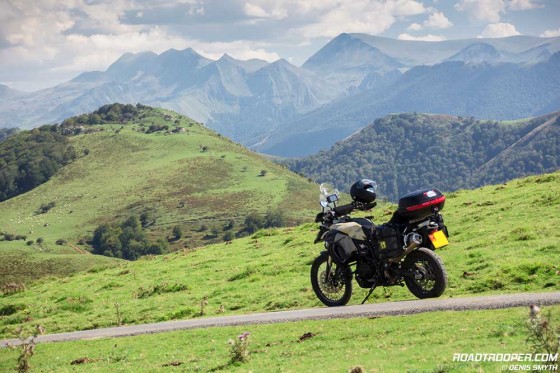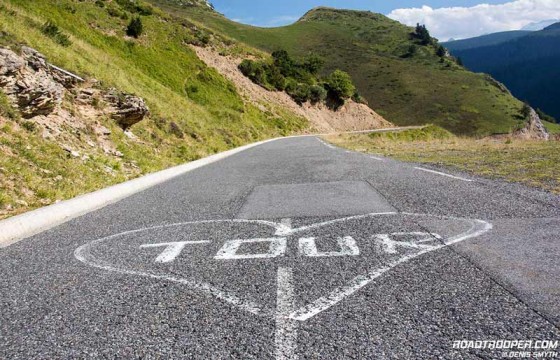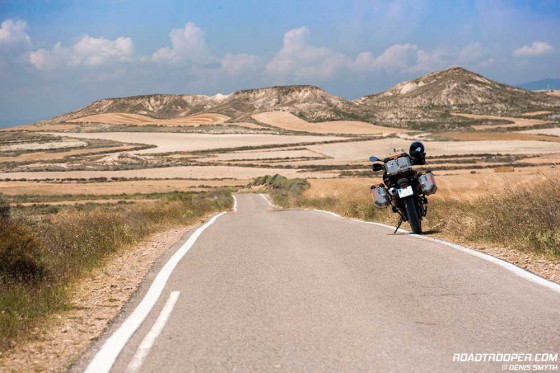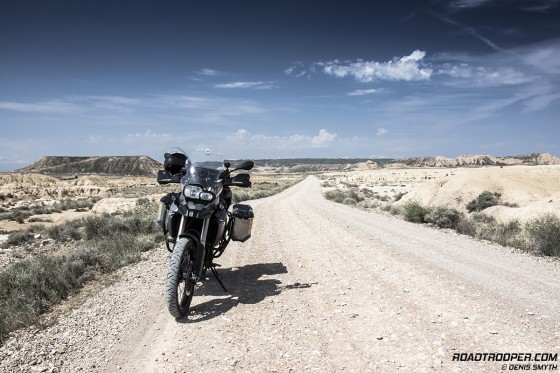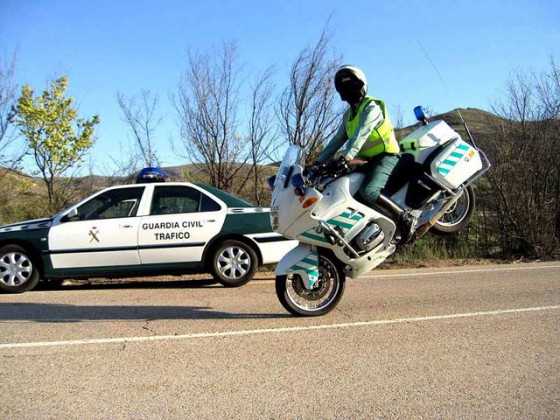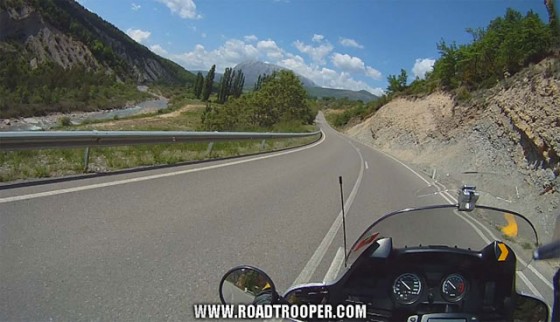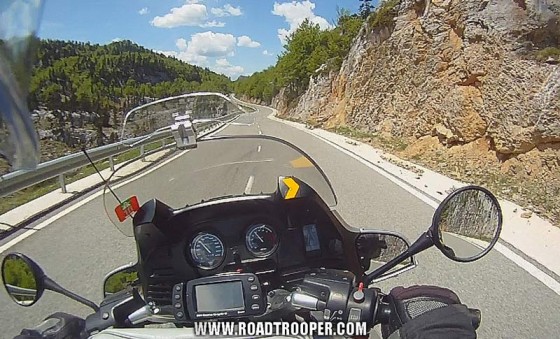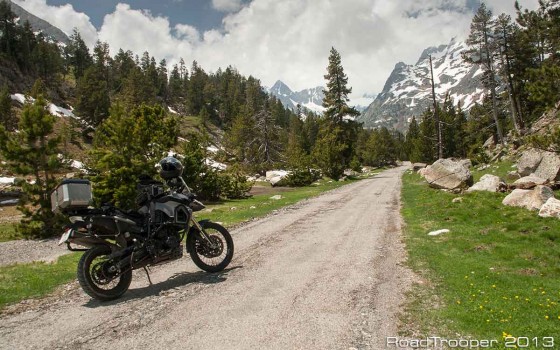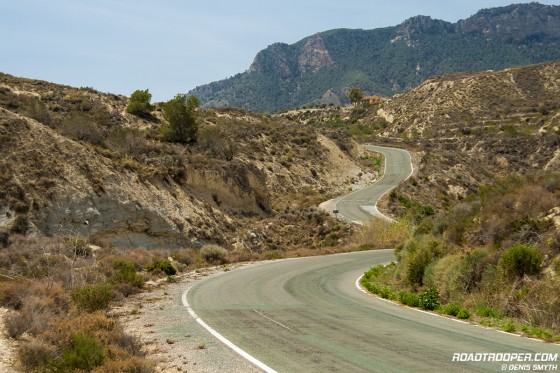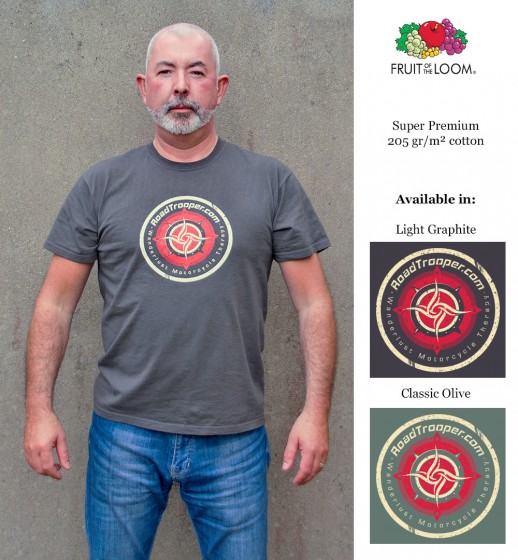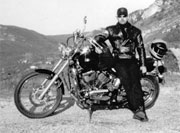The Spanish Guardia Civil Trafico will be targeting motorcyclists in a new safety campaign over the coming months.
For those heading to Spain to take advantage of Spain’s 660,000km road network, most of it sunny, you may want to be aware that the Guardia Civil Trafico have been ordered to take special attention to motorcyclists, both foreign and domestic. Speeding fines are also set to increase to combat a rather depressing set of statistics. The local perception in Spain is that speeding and traffic law infringement fines are just another hidden tax, and to be honest I have felt the same way having being stopped more than a few times by the GC Traffico and border guard divisions.
This summer they yet again seem to be setting their sights on motorcyclists. However, to give a better insight as to the reasons for this and how it really shouldn’t affect your tour of Spain this year it might be better to look at the broader picture as there seems to be a valid reason for it.
Traffic Fines
In the first three quarters of 2015 a mind blowing 127.4 million euro has been collected from Spanish drivers caught by fixed and mobile radars. In 2014, the total was 129.6 million, increasing from 124 million in 2013 and 120 million in 2012. Based on that the end of year figure for 2015 will be almost 170 million, as far as I’m aware the final figure is yet to be released. Long story short speedy Spanish motorists are handing over 470,000 euro every single day. The figures show a continual increase in the trend for speeders being fined, increasing from 355,075 euro per day in 2014 to the 470,396 euro per day in 2015.
This coincides with my own observations over the years that sticking to the speed limit is the exception rather than the rule on many Spanish roads. This is really an ongoing Spanish issue and far from unique, every country has it’s problems as fellow travelers well know, but what you need to take from this is that in Spain speeding is still commonplace, and between mobile (which includes helicopters) and fixed cameras the Guardia Civil Trafico are well set up to catch offenders. The GC are extremely effective in catching speedsters and are about to get better at it with the introduction of the new Spanish developed TrafficEye System which will go live on June 1st. Not only recognising reg plates, this system can check and report speeding, jumping red lights, will check vehicle is insured and if rider is using a SatNav while riding. It will even spot if a child in the rear is not wearing a seat belt. It will also spot you overtaking or lane changing illegally. If you are on a Spanish plate the fine is sent directly to your bank account that’s registered for paying the Spanish road tax. For foreign reg plates the system will notify the nearest Guardia Civil Traffico vehicle to intercept offenders for an on-the-spot fine so tourists can enjoy the personal touch.
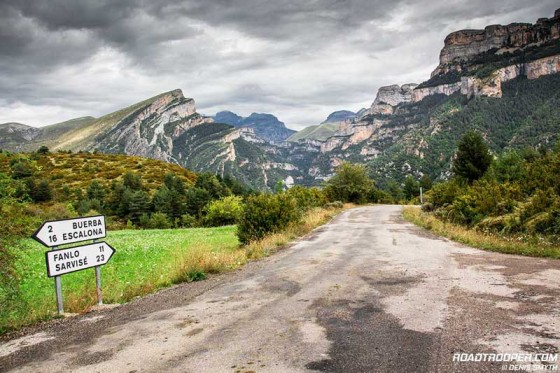
Even in the tail end of rural Spain you can meet the Guardia Civil, I have not far from this spot in the Pyrenees. They don’t like their photo taken though and it’s best not to try ![]()
Like I said, this is an ongoing Spanish situation which need not involve you, if you keep a close eye on your speed you will keep your hard earned cash in your wallet. You may also want to keep a close eye on your rear view mirrors as many cars in Spain come up from behind faster than you’re used to and steer clear of danger caused by others. This can so easily happen when touring abroad as you are inevitably distracted by new sights and all the rest. On the road I’ve learned to trust myself but no one else and use road signs to prompt me to check my mirrors. Good practice is to give both mirrors a quick check every time you see any form of road sign or signal, approaching a corner and certainly exiting a corner that opens onto a straight stretch where someone is likely to overtake you. It’s good practice anywhere at anytime, but it’s a habit that’s particularly kept me out of trouble in southern Europe over the last 16 years.
Keeping your speed in check will not however stop you getting pulled by the Guardia Civil this year as there is more to the story.
Motorcyclist Deaths Increasing
According to successive annual reports issued by the Ministry of the Interior, 270 motorcycle deaths were recorded in 2011; 218 in 2012; 215 in 2013; 187 in 2014; and 247 in 2015. The data shows that a downward trend had been consistent, but the massive increase last year has given considerable cause for concern to the powers that be. Basically what’s happening is that Spanish bikers are getting a bad name again for the suits in power so the GC’s have been told to keep a very close eye on us. What’s actually happening is that there is simply more traffic, cars, motorcycles, trucks etc on Spanish roads which results in a knock effect pushing the statistics up.
In February of 2015, following a 40% increase in speed related deaths in January, it was announced that more focus would be given to secondary roads, which account for 80% of all related fatalities, a figure which compares directly with the 81% increase in speeding motorists caught on this type of road. You might want to take note of this as it’s the secondary roads us bikers like to play on.
Despite positive trends to reduce the number of fatalities on the roads of Spain, 2015 ended with the worst results for four years for deaths involving motorbikes. The DGT (Dirección General de Tráfico) also believes that the increase in deaths is also related to the increase in use of vehicles. The economic upturn in 2015 resulted in an increase in traffic on the roads, partly for leisure and partly for work, as more people also managed to secure a job. In addition, according to the Bikers Mutual Association, the improved weather conditions throughout the year, especially during holidays such as Easter, meant that motorbike use seemed a more attractive option than ever before.
María José Alonso, Vice President of the Bikers Road Safety Platform, has blamed the authorities for not doing enough, especially in rural areas, by not improving roads and for not placing proper signage in appropriate places. Many other groups representing the riders themselves are also denouncing the poor state of the roads and the lack of investment. The Spanish Road Association released a report claiming that the situation of the roads was “the worst since 1985” and that it needs 6,500 million euro investment in order to return them to their optimal state.
Moreover, according to data from the DGT, 18% of motorcyclists killed in 2015 died after crashing into a crash barrier, according to the group, reinforcing their calls for improvements or the rehabilitation of the roadbed, repairing the many cracks, potholes and poorly painted pavements, whilst also demanding that all crash barriers be replaced by those specifically designed to assist motorcyclists in the event of a collision.
Personally I have my own take on much of these statistics and conclusions. And “the poor state of the roads” to me sounds like a bit of an excuse for poor riding skills in single vehicle collisions, or bad driving/and or riding skills in multi vehicle collisions. Try to ride on secondary roads on Ireland’s west coast and you’ll know all about poor road conditions and lack of signage. My take is that poor roads make a ride more involving, more of a challenge, therefore more enjoyable and practice increases skill level. Piss poor roads is also a possible reason why many find adventure style bikes are more practical as they handle better in the rough. But that’s just my opinion be it right or wrong, but from my experience Spanish roads are beautifully smooth comparing to Ireland, the UK or even much of the French D road network for that matter.
Anyway, all of this is just the back story to help understand how your trip to Spain may see you face being stopped by the Guardia Civil this summer, and how you should take this reality in your stride. At the end of the day the Guardia Civil have a job to do which is based on Spanish problems, not yours.
Safety Action Plan to Involve Motorcyclists
Spain’s Interior Minister, Jorge Fernández Díaz, has just announced a seven-point action plan for the roads of the country which are aimed at significantly reducing the number of casualties. In order to implement the plan, the government will allocate 7.2 million euro in funding towards the life saving measures.
These increased checkpoints will see vehicles stopped and their occupants/riders identified whilst also testing for alcohol and drug use, and the correct documentation, including ITV and insurance. The ITV is the Spanish MOT which is not necessarily applicable to you on a foreign reg bike if it is evident you are just a tourist. However a motorcycle in obvious poor state may be impounded, this includes worn or damaged tyres.
Expect to be stopped at roundabouts where traffic naturally slows both in rural and urban areas. If you are riding in a group stick together approaching checkpoints as you are less likely to be stopped. The GC’s are aware of the potential danger of waving down a lead motorcycle thus causing a collision from other bikes in a group coming behind. However they will look closely at your group and if they spot any road infractions they can follow and pull you in safely as a group or radio ahead and set up another checkpoint where they can stop a group safely.
In 2014 there were 91,570 injury incidents in which 1,688 people died and 9,574 were injured to such a severity they needed admission to a hospital. On average, there were 4.6 deaths on the road every day. In total, there were 247 motorcycle deaths on the main road network last year (2015), 60 more than in 2014, representing an increase of 32%. This has been the worst year since 2011 when a similar number of people lost their lives in motorbike related incidents.
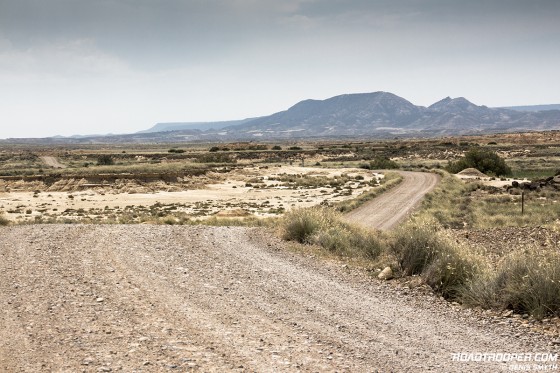
The Bardenas Reales in Aragon/Navarra is do-able on almost any road bike. The point being Spain has every type of road imaginable.
The Director General of the DGT, Maria Segui, had already expressed her concerns over the problem as 2015 was nearing a close, explaining the three apparent major contributing factors to the increase in motorcycle deaths, namely increased mobility, the rise in the average age of such vehicles, and an increasing number riders not wearing a helmet properly, of the deaths last year, 13 people were not wearing a helmet. Many more were found to be wearing a helmet incorrectly or had defective or damaged helmets. This was not the final number as death from complications brought on by road rash (from wearing t-shirts/shorts instead of proper gear) are not taken into account.
As part of the new road safety campaign 2016 will see motorcycles given considerably more attention with extra monitoring points on the roads and checks on documentation, as well as speed and dangerous manoeuvres. In recent months, 9% of motorcycles involved in injury incidents did not have an ITV/MOT. Some 15% of motorbikes were over 20 years of age, the point here being old models have less advanced braking systems and rider aids such as traction control as well as a long list of potential age related mechanical issues.
All of this is rather sobering, but again this is an issue in Spain which may inadvertently involve you this year with the increased checkpoints, and from what I’m hearing you should probably expect it. The purpose of this long winded story is simply to make you aware that Spain has it’s issues with it’s own driving and riding population. Spain has decided for it’s own reasons to implement measures that will hopefully make Spanish roads safer for us all, so if you do get stopped you really have nothing to worry about as long as you have your bike, paperwork, passport and head screwed on.

Spanish developed TrafficEye System will go live on June 1st, 2016 in 200 locations. Not only recognising reg plates, this system can check and report speeding, jumping red lights, will check vehicle is insured and if rider is using a SatNav while riding. It will even spot if a child in the rear is not wearing a seat belt.
Over the next 7 months (Spain’s summer period) there will be more checkpoints with the Guardia Civil paying special attention to motorcyclists as well as other targeted groups. As long as you have your ride properly serviced before you leave, replace tyres if in any doubt and keep your speed within posted limits you won’t have a problem. Be prepared to have your papers checked and possibly a roadside safety check of your bike when stopped and the rest is fun in the sun.
When dealing with the Guardia Civil be polite as they tend to be a serious bunch, most of whom have spent time in the military or were posted as peacekeepers in some of the world’s worst places which results in an “edgy” attitude. As is so often the case the ones riding bikes are the most friendly and are happy to receive and give a wave as they pass by. The GC’s on bikes always ride in pairs with one or both most likely being a medic while the other a mechanic with their job being predominantly to help road users in trouble. If you have an accident in a rural location these are the guys who will most likely turn up to help you until an ambulance arrives. I’ve also talked bikes with them in laybys as all bikers do, so while they are a serious bunch it’s good to know the ones on bikes have the same passion for bikes like ourselves and all are better trained to actually help you in a bad situation than many other police forces. I’ll never forget the day I was on my 800GS tearing up a dirt/unsurfaced road in Murcia only to be overtaken and utterly out-ridden by a GC on a 1200RT. He even had the time to kick out a leg as a wave making me feel like a right plonker thinking I was the business in all my off road gear while he was in a t-shirt and throwing the RT around like it was a 125 lol…
Don’t let any thought of being stopped by the GC, or the Speedy Spanish scare you off Spain. The data maintains Spain’s position in fifth place in the scale of European rankings by rate of fatalities with 36 deaths per million inhabitants, this is still well below the European average rate which stands at 52, and ahead of countries like France, Germany, Italy and even Finland which seems surprising.
Spain is one of the best countries in Europe to ride a motorbike and tour in and the best for trail and off road riding. It has a staggering road network, it is estimated that there are over 660,000 kilometres of roads, of which over 489,000 are urban, aprox 165,567 are intercity roads, of which 2% (3,036 km.) correspond to toll roads; 7% (11,682 km.) to free motorways and expressways; 1% (1,640 km.) of dual carriageways.
However the real fun is found on the 149,209 km of conventional roads making up the interior and the biker’s paradise of the Pyrenees and western coastline. Add affordable food, accommodation and plenty of sun into the mix and it’s a no-brainer.
If you’ve not been for a ride in Spain stop messing around and just go ![]()
20th Anniversary video of the Guardia Civil Trafico Academy
If you liked this article please help me pay the website costs and my motorcycle addiction by buying a RoadTrooper – Wanderlust Motorcycle Therapy T-Shirt
Stay safe, Denis
